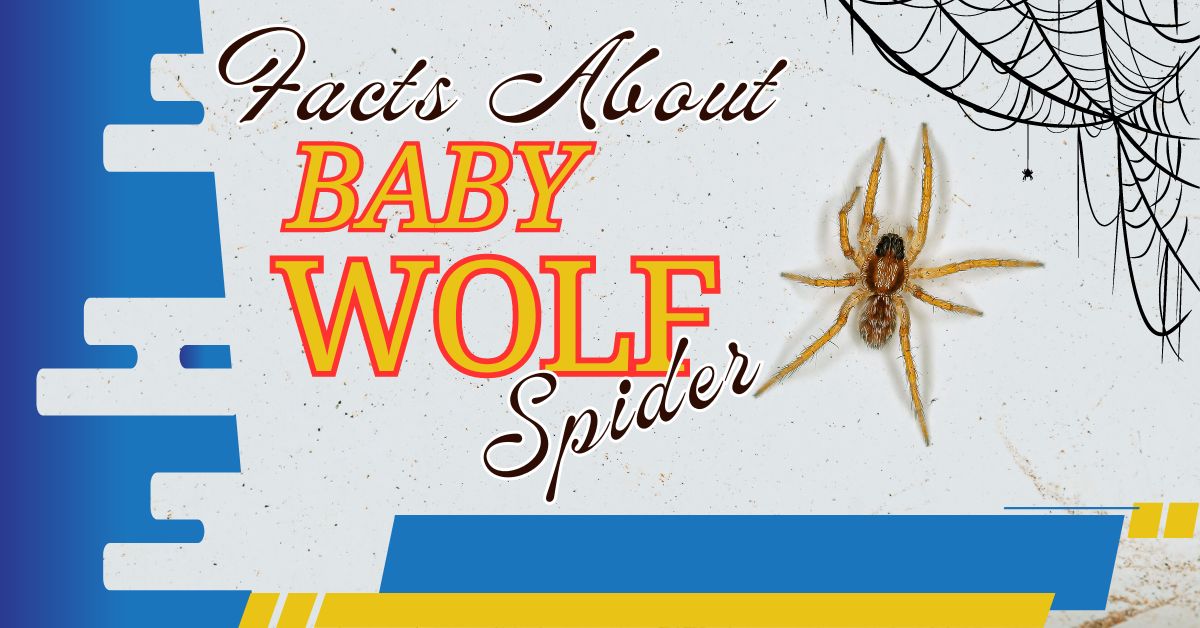Wolf spiders are among the most fascinating arachnids in the natural world. While adult wolf spiders are commonly recognized for their hunting skills and unique characteristics, baby wolf spiders have their own intriguing behaviors and life patterns. These tiny spiders are born in the safety of their mother’s care and quickly adapt to the wild environment they inhabit.
If you’re curious about baby wolf spiders, their life cycle, behavior, and how they differ from other spiders, here are 10 fascinating facts about baby wolf spiders that you won’t believe!
1. What Is a Baby Wolf Spider?
A baby wolf spider is the young form of a wolf spider, belonging to the Lycosidae family. Unlike other spiders that spin webs to catch prey, wolf spiders, including their babies, are agile hunters that rely on speed and stealth to capture their food. Baby wolf spiders hatch from egg sacs carried by their mother, which is a unique feature compared to most other spider species.
After hatching, baby wolf spiders, also called spiderlings, cling to their mother’s back for a short time before venturing into the world. Their survival skills are honed from a very young age, and they soon become adept hunters, much like their adult counterparts.
2. How to Identify a Baby Wolf Spider
Identifying a baby wolf spider can be challenging for those unfamiliar with the species. They are typically small, measuring only a few millimeters in length when they hatch. They are often brown or gray with markings that help camouflage them in their natural environment.
One of the key characteristics of wolf spiders, even as babies, is their large eyes. Wolf spiders have eight eyes arranged in three rows, with the middle pair being particularly large and forward-facing. This gives them excellent vision, which is crucial for hunting prey. They already exhibit this distinctive eye arrangement, making it a primary identifier.
Another feature that sets baby wolf spiders apart is their hairy body and legs, which they inherit from their mother. The tiny hairs, called setae, help them sense vibrations and movements in their environment, aiding in their survival.
3. The Life Cycle of a Baby Wolf Spider
The life cycle of a baby wolf spider begins in an egg sac, which is carefully crafted and carried by the female wolf spider. The mother protects the eggs until they are ready to hatch. This can take several weeks, depending on environmental conditions.
Once the eggs hatch, the baby wolf spiders emerge as spiderlings and immediately cling to their mother’s back for protection. This is a unique behavior, as most spider species leave their young to fend for themselves. The mother wolf spider carries her babies for about a week before they begin to disperse.
As the baby wolf spiders grow, they go through several molts, shedding their exoskeleton to make room for their growing bodies. Each molt marks a new stage in their development, eventually leading them to adulthood. The entire life cycle, from egg to adult, can take up to two years, depending on the species and environmental factors.
4. What Do Baby Wolf Spiders Eat?
Like their adult counterparts, they are carnivorous hunters. They primarily feed on small insects, including flies, ants, and even other smaller spiders. Their diet is essential to their development, as they need plenty of protein to grow and molt.
One of the fascinating aspects of baby wolf spiders is their ability to hunt and capture prey almost immediately after they leave their mother’s care. Unlike spiders that rely on webs, wolf spiders actively hunt their food, using their agility and keen eyesight to track down and catch their prey.
In captivity, they can be fed small insects like fruit flies or tiny crickets. It’s important to note that they require live prey, as they rely on movement to trigger their hunting instincts.
5. Where Do Baby Wolf Spiders Live?
Baby wolf spiders can be found in a wide variety of habitats, ranging from forests and grasslands to deserts and suburban backyards. Wolf spiders are highly adaptable creatures, and their babies are no different. They typically prefer habitats where they can easily find shelter and prey.
Wolf spiders, including their babies, are ground-dwelling spiders that often take refuge under rocks, leaves, and debris. They do not spin webs to live in, unlike many other spiders, but instead create burrows or find existing shelters where they can hide during the day and hunt at night.
In suburban areas, baby wolf spiders might be found in gardens, wood piles, or even inside homes. While their presence might be alarming to some, wolf spiders are generally harmless to humans and play a crucial role in controlling insect populations.
6. Behavior and Habits of Baby Wolf Spiders
Baby wolf spiders are solitary hunters, even from a young age. After they leave their mother’s back, they become independent and rely on their instincts to survive. One of their most distinctive behaviors is their reliance on their vision and agility for hunting.
These spiders are nocturnal, meaning they are most active at night. During the day, baby wolf spiders hide in burrows or beneath rocks, emerging at night to hunt. Unlike spiders that use webs to trap their prey, wolf spiders actively chase down their food, using short bursts of speed to catch insects.
Another interesting behavior of baby wolf spiders is their ability to move quickly and evade predators. Even at a young age, they are highly alert and will retreat to safety at the slightest sign of danger. Their excellent eyesight, combined with their ability to sense vibrations, helps them navigate their environment effectively.
7. How to Care for a Baby Wolf Spider at Home
While wolf spiders are often found in the wild, some people choose to keep them as pets due to their fascinating behaviors. If you are interested in keeping a them at home, there are a few important care guidelines to follow.
- Housing: A small terrarium or enclosure with proper ventilation is ideal for a baby wolf spider. The enclosure should have hiding places, such as rocks or small branches, to simulate their natural environment.
- Substrate: Use soil or a mix of sand and peat moss as the substrate. This allows the spider to create a burrow if desired.
- Feeding: They need a steady diet of live insects, such as fruit flies or pinhead crickets. Ensure the prey is appropriately sized for the spider to catch and eat.
- Humidity and Temperature: Wolf spiders generally thrive in room-temperature environments, with a moderate level of humidity. Mist the enclosure lightly once a week to maintain proper moisture levels.
Remember that are solitary creatures and should not be housed with other spiders, as they may become aggressive or territorial.
8. Interesting Facts About Baby Wolf Spiders
Here are some surprising facts about that you probably didn’t know:
- Motherly Care: Wolf spider mothers carry their egg sacs and baby spiderlings on their back, a rare behavior among spiders.
- Excellent Vision: Even as babies, wolf spiders have incredible eyesight, making them effective hunters.
- Ground-Dwellers: Unlike many spiders, they don’t spin webs. Instead, they create burrows or hide under debris.
- Camouflage Experts: The coloring and markings of baby wolf spiders help them blend into their surroundings, making them difficult for predators to spot.
- Fast Runners: They are surprisingly fast for their size, a trait that helps them catch prey and escape danger
If you’re interested in learning more about home safety concerning spiders, check out 7 Crucial Facts About Red Spiders You Need to Know for Home Safety here!
Conclusion
Baby wolf spiders are fascinating creatures with unique behaviors and survival skills. From their early days as spiderlings clinging to their mother’s back to their development into skilled hunters, these spiders are an important part of the ecosystem. Whether you’re a spider enthusiast or someone who encounters these creatures in the wild, understanding their life cycle, diet, and behavior adds to the appreciation of their role in nature.
While baby wolf spiders might be small and unassuming, their agility, independence, and hunting prowess make them one of the most intriguing arachnids. By learning more about them, we can better appreciate their significance in maintaining ecological balance.
FAQs
- What is a baby wolf spider?
- It is the juvenile form of the wolf spider, born from an egg sac and carried by the mother for protection.
- How can I identify a baby wolf spider?
- They are small, usually brown or gray, with distinct markings and large eyes arranged in three rows.
- What do baby wolf spiders eat?
- They eat small insects like fruit flies and ants. They hunt rather than use webs to catch prey.
- Where do baby wolf spiders live?
- They can be found in various environments, including forests, deserts, grasslands, and suburban areas.
- How fast do baby wolf spiders grow?
- They go through several molts as they grow, taking up to two years to reach adulthood.
- Are baby wolf spiders dangerous?
- No, they are not dangerous to humans. They are shy and avoid human contact.
- Can I keep a baby wolf spider as a pet?
- Yes, they can be kept as pets with proper care, including a well-ventilated enclosure and a steady diet of live insects.
- Do baby wolf spiders spin webs?
- No, wolf spiders, including their babies, are ground-dwellers that do not spin webs to catch prey.
- How do baby wolf spiders defend themselves?
- They rely on their speed, agility, and camouflage to evade predators.
- How long do baby wolf spiders stay with their mother?
- They stay with their mother for about a week before dispersing and becoming independent.




